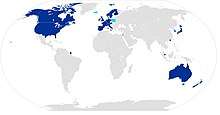Developed market

In investing, a developed market is a country that is most developed in terms of its economy and capital markets. The country must be high income, but this also includes openness to foreign ownership, ease of capital movement, and efficiency of market institutions. This term is contrasted with developing market (Emerging markets and frontier markets are types of developing markets).
FTSE Group list
FTSE Group, a provider of economic and financial data, assigns the market status of countries as Developed, Advanced Emerging, Secondary Emerging or Frontier on the basis of their economic size, wealth, quality of markets, depth of markets, breadth of markets. From 24 September 2018, FTSE Group classifies 25 countries as developed markets:[1][2]
FTSE Criteria
Developed countries all have met criteria under the following categories:[3]
- They are high income economies (as measured by the World Bank GNI per capita Rating, Market and Regulatory Environment)
- Formal stock market regulatory authorities actively monitor market (e.g., SEC, FSA, SFC)
- Fair and non-prejudicial treatment of minority shareholders
- Non or selective incidence of foreign ownership restrictions
- No objections or significant restrictions or penalties applied on the repatriation of capital
- Free and well-developed equity market
- Free and well-developed foreign exchange market
- Non or simple registration process for foreign investors
- Custody and Settlement
- Settlement - Rare incidence of failed trades
- Custody-Sufficient competition to ensure high quality custodian services
- Clearing & settlement - T +3 or shorter, T+7 or shorter for Frontier
- Stock Lending is permitted
- Settlement - Free delivery available
- Custody - Omnibus account facilities available to international investors
- Dealing Landscape
- Brokerage - Sufficient competition to ensure high quality broker services
- Liquidity - Sufficient broad market liquidity to support sizeable global investment
- Transaction costs - implicit and explicit costs to be reasonable and competitive
- Short sales permitted
- Off-exchange transactions permitted
- Efficient trading mechanism
- Transparency - market depth information / visibility and timely trade reporting process
- Derivatives
- Developed derivatives markets
- Size of Market
- Market Capitalisation
- Total Number of Listed Companies (as at 31st Dec 2008)
MSCI list
As of October 2017, MSCI classified the following 26 countries as developed markets:[4]
According to MSCI Global investable Market Indexes Methodology - October 2017,[5] Cyprus as well as Iceland and Luxembourg, "are part of the developed market universe", but "given their modest size, these markets are not included in the MSCI World index".
S&P list
As of 31 October 2017, Standard and Poor's classifies the following 25 countries as developed markets:[6]
Table
See also
References
- ↑ FTSE Developed Index, p. 3.
- ↑ FTSE Russell Reclassifies Poland To Developed Market Status
- ↑ http://www.ftse.com/products/downloads/FTSE_Country_Classification_Paper.pdf and http://www.ftse.com/products/downloads/Asia-Pacific_latest.pdf
- ↑ MSCI Global investable Market Indexes Methodology - October 2017, p. 74 footnote #40. See also: MSCI developed markets.
- ↑ p. 74 footnote #40.]
- ↑ S&P Global Equity Indices Monthly Update, Oct. 31 2017, p 2.
- ↑ FTSE Developed Index, p. 3.
- ↑ "FTSE Russell announces results of FTSE annual country classification review". FTSE Russell. 2017-09-29. Retrieved 2017-10-18.
- ↑ MSCI Global investable Market Indexes Methodology - October 2017, p. 74 footnote #40. See also: MSCI developed markets.
- ↑ S&P Global Equity Indices Monthly Update, Oct. 31 2017, p 2.